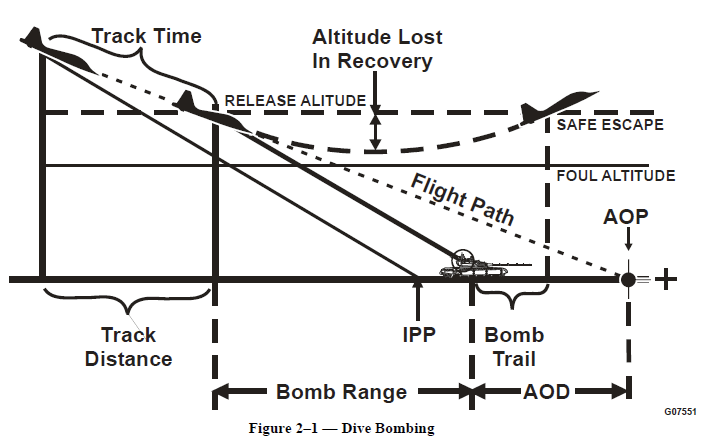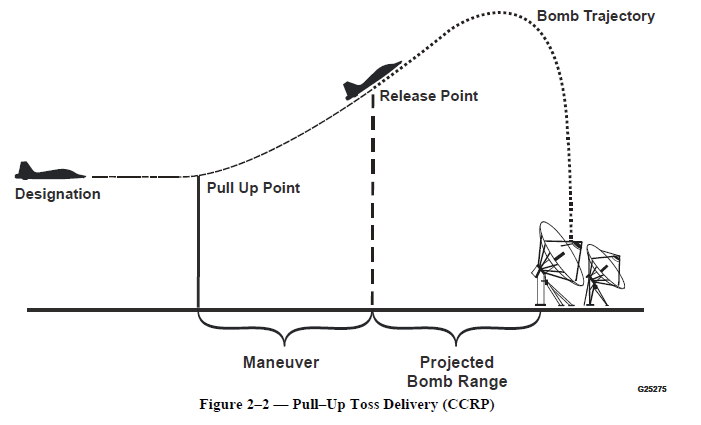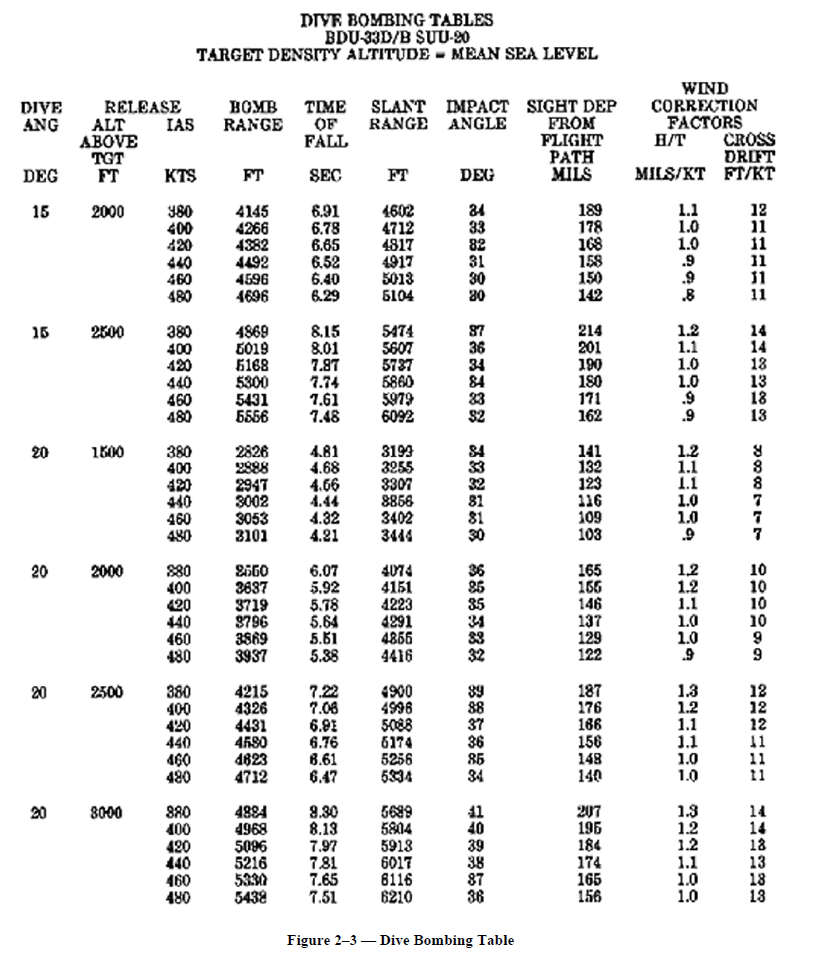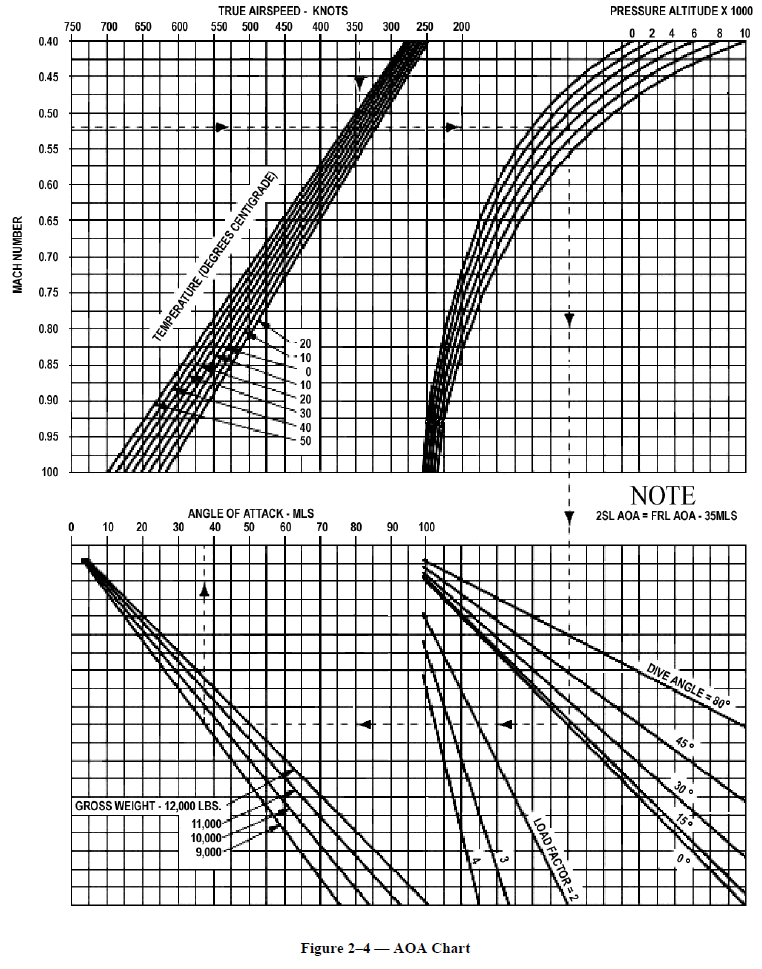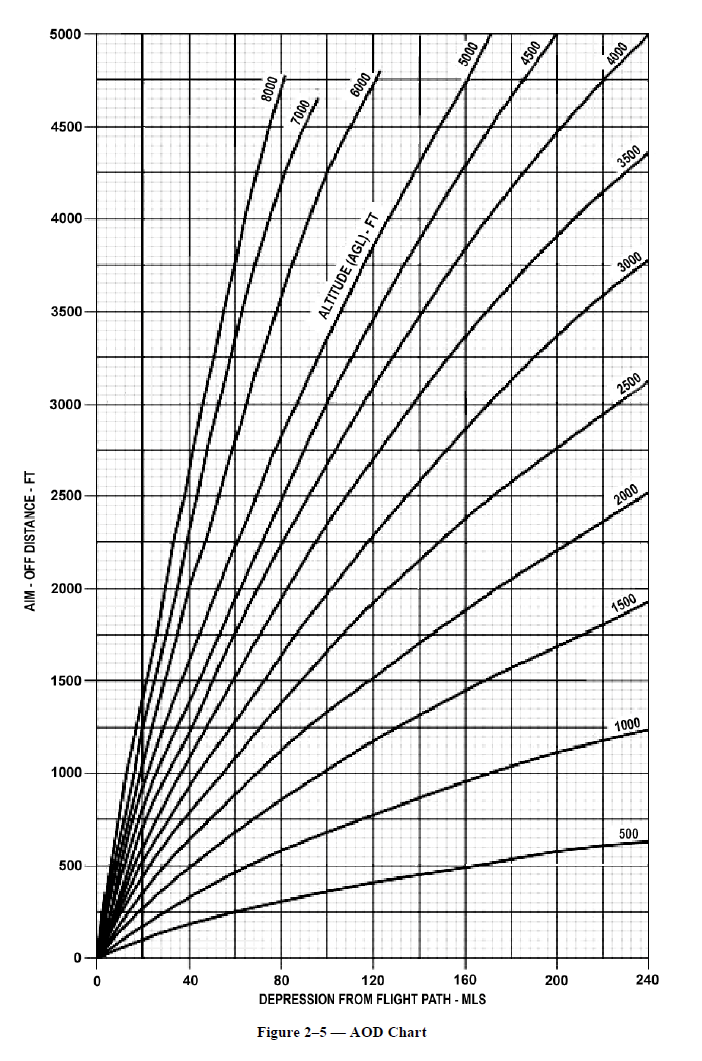SA-2 Surface Attack Basics
Objectives
1. State the basic history and development of bombing theory.
2. Identify the various parameters used to describe the bombing maneuvers.
3. Know the formula for computing a manual sight setting for the T–38C.
Assignment
1. Review Lesson SA–2, Surface Attack Basics, in the Surface Attack student guide, B/F-V5A-K-SA-SG.
2. Review MCMAN 11-238 Vol 2, Section 4.2, Basic Bombing.
3. Review and bring to class local In–Flight Guide, Surface Attack pages.
4. Review T.O. 1T-38C-1, T–38C Flight Manual, Section V for aircraft limitations.
5. Review T.O. 1T-38C-34-1-1CL-1, T–38C Flight Crew Weapon Delivery Checklist for familiarity.
6. Review T.O. 1T-38C-34-1-1, T–38C Weapon Delivery Manual for familiarity.
7. Complete SA–2 review exercise.
Information
Basic Bombing Theory
Objective 1 — State the basic history and development of bombing theory.
1. Dropping some type of weapon from airships and airplanes has been around since each vehicle was invented.
During WWI bombing was done by flying low over the target and hand dropping a “bomb” over the side. Or,
essentially level bombing.
2. As aircraft capabilities improved so did the tactics for aerial bombing. During the years between WWI and WWII
the German Air Force refined the tactics that were started by the US Navy. The Stuka was the airframe of choice to be
the “dive bomber”. During WWII strategic bombing was mostly done high altitude and from a level attitude. Tactical
bombing and strafing was done from low altitude with more maneuverable aircraft. Since then the weapons, delivery
vehicles, avionics and the tactics used to employ the weapons have taken huge leaps in technology.
3. Even though we see the effects of guided “smart” weapons everyday, the reasons for dive–bombing and the
procedures used are all very similar to the days of the “Stuka”. A look at the basics is important for us to understand
how the “computer” can do it all for us. The computer knows where the bomb will impact the ground but the pilot
must still get that release point to be over the correct target. First, let’s look at level versus dive–bombing. These two
methods are considered “direct” bombing because the pilot has visual on the intended target.
a. Diving at 90° or straight down at the target has some advantages. One is that you are pointed directly at the
target the entire time. However, the release must be done at a high altitude in order to recover from the dive.
b. Level bombing will allow the bomb to be released at a much lower altitude but target acquisition is much
harder. Aim points well beyond the target must be found and used to get the bomb on target. With the lower
release altitude chances of being in the bomb fragment pattern when the bomb explodes is much greater.
c. A compromise between the two extremes was developed. Most training deliveries are made from 10, 20, or
30° dive angles. The type of free fall munitions will determine the best dive angle for delivery.
d. The trajectory of each weapon is the result of the release options (e.g., loft/level/dive), release velocity, release
altitude, release angle, gravity, and the drag characteristic of the weapon itself. Each weapon must be able to “kill”
the target without killing the aircraft that delivered the weapon.
4. Getting the weapon safely to the target requires that numerous factors be taken into account. The most important
factor is altitude. The minimum release altitude is affected by:
a. Ability to safely escape from the primary and secondary weapon fragments.
b. Weapon fuze time.
c. Ability to safely escape from a premature detonation.
5. The aircraft that delivered the weapon must be able to survive and fight another day. With every release the pilot
must be aware of the minimum release and recovery altitudes. Releasing below the minimum release altitude may
make recovery impossible or at the least place your aircraft in the bomb fragment pattern.
6. Another weapons employment capability is the climb/loft/toss delivery. These type deliveries are considered
“indirect bombing” since the pilot probably does not have visual on the target at weapon release. The Continuously
Computing Release Point (CCRP) mode in the T–38C emulates an F–16 indirect or toss bomb delivery mode.
Definitions
Objective 2 — Identify the various parameters used to describe the bombing maneuvers.
1. The principles of bombing all use the same rules and definitions whether the release is manual or Continuously
Computing Impact Point (CCIP). The terminology for Continuously Computing Release Point (CCRP) deliveries is
slightly different, but the basic concepts still apply. These definitions provide the how and why a bomb goes where it
does (see Figure 2-1).
2. The list of definitions include:
a. Aim–Off Distance (AOD): The horizontal distance past the target to the intersection of the flight path and the
earth surface.
b. Aim–Off Point (AOP): An imaginary point where the flight path intersects the ground. During a no–wind
situation, this point is 12 o’clock to the target.
c. Angle of Attack (AOA): Angle between the Fuselage Reference Line and the Flight Path.
d. Bomb Trajectory: The freefall path the bomb takes as it travels to the target. Bomb drag (design) will have an
effect on this path after the bomb is released from the aircraft
e. Bomb Range: The horizontal ground distance from weapon release to impact.
f. Bomb Tail: The horizontal distance between the aircraft and bomb impact.
g. Flight Path (FP): The path of the aircraft with reference to the air mass.
h. Fuselage Reference Line (FRL): A basic reference line extending through the fuselage in the longitudinal axis
of the aircraft.
i. Safe Escape: Maneuver flown to transition the aircraft out of the delivery mode. The maneuver flown will
take the aircraft away from the ground and out of the fragment pattern.
j. Sight Depression from Flight Path (SDFP): The optical sight depression value from the flight path in MILs.
k. Sight Line (SL): A line from the pilot’s eye through the pipper to the target.
l. Sight Setting (SS): The angle in MILs accounting for flight conditions at release and sight depression from
flight path (SDFP).
m. Slant Range: The straight–line distance from the target to the aircraft at bomb release.
n. Time of Fall (TOF): The time it takes from bomb release to bomb impact.
o. Track Distance (TD): The horizontal distance the aircraft travels from rollout on final to release altitude.
p. Track Time: The time the aircraft is on final prior to release.
q. Initial Pipper Placement (IPP): The placement of the pipper short of the target when first rolling out on final
(at track altitude). This is where the pipper is at when aligned with the proper Aim–Off Point.
3. Indirect bombing (the pilot probably does not have visual on the target at weapon release) includes loft or toss type
deliveries. This capability is provided via the Continuously Computing Release Point (CCRP) system on the T-38C. It
closely resembles the F–16 CCRP delivery mode (see Figure 2-2).
a. Slightly different bombing terms, but the basic bombing concepts apply. CCRP HUD symbology is slightly
different from the CCIP symbology.
b. The CCRP is a different bombing algorithm from CCIP and is more dependent on the accuracy of the target
lat/long and altitude.
4. These definitions and many more terms are contained in the T–38C Weapon Delivery Manual. This manual will
be your main reference to the weapons parameters that you will use to deliver weapons in the T–38C and also for your
follow–on aircraft. You may also use the Combat Weapons Delivery Software that is part of the Portable Flight
Planning Software (PFPS) to get the most current data for your aircraft and weapon.
Sight Setting
Objective 3 — Know the formula for computing a manual sight setting for the T–38C.
1. Manual Sight Setting (SS): For this discussion we will use Weapon Delivery Manual charts from the AT–38B,
which had a manual sight. (The T–38C Weapon Delivery Manual does not include bombing tables as manual bombing
is not done at IFF.)
a. In manual bombing, the sight is set to indicate aircraft arrival at the proper release point. To determine the
correct SS or sight depression, we must look at the geometry between aircraft and target at the instant the bomb is
released.
b. The manual sight setting formula for the T–38C is:
SS = SDFP + AOA
c. From the dive bombing tables that are normally found in the Dash–34 the SDFP can be determined in MILs.
To use the table the following variables or parameters must be known:
(1) Weapon type
(2) Target density altitude
(3) Dive angle
(4) Release airspeed
(5) Release altitude
d. For an example calculation use 20° dive angle, 420 KIAS (420 KCAS will be seen in the aircraft), 2,000 ft
AGL, and a BDU–33 weapon. From these parameters the SDFP is 146 MILs. See Figure 2–3.
e. The AOA can be determined from the AOA Sight Setting chart in MILs also, see Figure 2–4. AOA is
required because most sights are mounted to the aircraft parallel to the longitudinal axis or fuselage reference line
(FRL). The angle between the FRL and flightpath is the angle of attack (AOA). If the sight were attached to the
flight path (FP) then SDFP would be equal to sight setting.
f. For this example the AOA at release is 22 MILs. The SS is then 146 + 22 or 168 MILs. This is the amount
that the manual sight will be depressed.
g. The SS is constant from rollout to release. However, the AOA part of our SS formula changes as the aircraft
accelerates in the dive. The AOD charts in the Dash–34 provide a means to find where the pipper ought to be at
any point along the flightpath from rollout to release while taking into account the AOA change.
h. Using the AOD chart, see Figure 2–5 the example problem equates to an AOD of 1,750 ft.
2. The AOD is how far past the target your flight path must be to have the pipper on target at release altitude. The
pipper will initially be short of the target as you roll out with the appropriate AOD. As you continue down the wire the
pipper will appear to move up and be on the target at the release point.
3. With a computing sight all of the variables are taken into account by the computer. The computer will show where
the bomb will impact throughout the bombing run. If the pipper is flown over the target and the pickle button is
pressed with the pipper on the target the bomb will hit the target. This all sounds very easy but it still requires precise
flying of the aircraft.
4. The pilot must still roll out on final with the flight path marker (FPM) on the AOP. This will place the pipper
below the target as the aircraft moves forward to the target. Steering is provided by the bomb fall line (BFL) as the line
should remain through the target as you move forward to release. The BFL represents the slant range distance from the
aircraft to the target. Hence the AOP/AOD is a percentage of the BFL. In very general terms the AOD is
approximately 40% of the BFL length. The computer will compensate for changes in parameters. As long as the
pipper is on target at release the bomb will hit the target.
5. The major parameter the pilot must be constantly aware of is altitude. Both planned and minimum altitudes must
be taken into account. As a general rule if you are steep by up to 5° or fast by as much as 30 knots you should go no
lower than planned release altitude. If dive angle is correct or a little shallow the pattern can be flow to the minimum
release altitude.
Summary
1. Basic bombing theory
2. Definitions
3. Computing a manual Sight Setting (SS)
Review Exercise SA–2
Complete the following review exercise by choosing the correct responses. Answers are in Attachment 1.
1. What is the Formula for a T–38C manual Sight Setting:
a. SDFP + AOD
b. SDFP + FRL
c. SDFP + AOA
d. SDFP + Dive Angle
2. Match definitions from MCMAN 11-238, VOL 2:
a. Bomb range __________ 1. Horizontal distance aircraft travels from rollout on final to
release altitude
b. Slant range __________ 2. Straight–line distance from the aircraft to the target at
bomb release
c. Bomb trail __________ 3. Horizontal distance between the aircraft and bomb at
impact
d. Track distance __________ 4. The horizontal distance the bomb travels from release to
impact
3. Match definitions from MCMAN 11-238, VOL 2:
a. Fuselage Reference Line (FRL) _______ 1. Distance from target to the intersection of the flight path
and the ground
b. Aim–Off Point (AOP) __________ 2. Placement of the pipper short of the target when first
rolling out on final (at track altitude)
c. Aim–Off Distance (AOD) __________ 3. Line parallel to the longitudinal axis of aircraft
d. Initial Pipper Placement (IPP) _________ 4. Point where flight path intersects the ground. No–wind,
point is 12 o’clock to the target.

